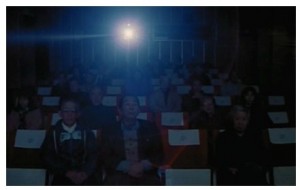
The Case of Karagarga
by Lukas Oscar Lacey-Hughes | December 23, 2022
The modern cinematic experience faces a sustained dilemma. Once offering new models of seeing intended to tempt back waning audiences, the cinematic spectacle has become a parody of itself. An ethics of experience has supplanted film-viewing itself in the discourse surrounding the medium.
Martin Scorsese acknowledged this shift in an infamous 2018 interview, drawing a distinction between auteur-led “cinema” and the gaudy “theme parks” of modern superhero films. This dichotomy reproduces itself at many levels in the current state of cinema, both from a standpoint of cultural critique and for enterprises that seek to offer experiential alternatives to theatrical releases.
Secret Cinema, a London-based events company, is such an enterprise that has flourished in recent years and has made a particular comeback since the end of the pandemic. Spectators are offered a host of experiences accompanying classic blockbuster films, screened at initially undisclosed locations that are revealed as part of the merry-go-round of the viewing, generating viewer interaction and a level of covertness unavailable in the usual cinema-going experience.
The experiential promise of a unique screening is complemented by the types of films that Secret Cinema usually shows: immensely popular blockbusters with established fan communities. Rather than undercutting the esoteric and covert promise of the endeavour, Secret Cinema doubles down on its eponymous guarantee by allowing its audience to experience something they are already familiar with. The secret is itself the experience, which is conceived entirely outside of the particular film being shown.
The promise of secrecy marks the inability of the usual theatrical cinematic experience to satisfy the normative viewer. These companies have even moved beyond films, screening any media that aligns with their model of excessive over-consumption. Indeed, since 2017, Secret Cinema has presented marathon screenings of huge Netflix titles like Stranger Things and Arcane, suggesting a shared trajectory between the extra-cinematic spectacle that Secret Cinema offers and the mesmeric indulgence of the binge-watch.
Such a quest for secrecy, as an antidote to the waning prowess of the cinema as a viewership model, seems like a symptom of the state of media consumption in the digital age. This poses a wider question, which translates especially to a variety of alternative viewership models that have flourished in the last decade: namely, how do we keep hold of the mysterious power of secrecy in an age where everything is immediately accessible? The online forum and video-sharing archive Karagarga shares such concerns and even provides some possible answers.
My introduction to the website occurred when I came across a Goodreads account that had been giving polemically low ratings to 20th-century philosophical literature. When I visited this user’s profile, I came across an enigmatic proposition. In the description box was a sentence that seemed out of place on a Goodreads: “Selling Karagarga invites for $75.”
What I came to learn about this summoning statement opened me up to an alternative culture of film viewership. Amid the majority of pirated activity online, this particular forum stands out in terms of its orientation and dedication to the archival preservation of obscure, lost, and damaged films. Karagarga is a forum made possible by the technology of a BitTorrent tracker, through which media files can be shared peer to peer over a decentralised network. BitTorrent is a special kind of server that creates metadata files with competing, overlapping instructions, thereby coding downloadable media files to be transferred across multiple server addresses at once. It is a programme that generates the majority of pirated activity online. BitTorrent had an estimated 150 million active users as of 2012 and is used on prominent piracy sites such as The Pirate Bay, Putlocker, and Library Genesis.
In contrast to the mainstream piracy which seeks to democratise audio-visual media through a series of debasing alterations, diluting the file quality in favour of convenient access, Karagarga prioritises preservation and cultural fulfilment. It cultivates a curated library of obscure arthouse media and wields upload quality as the benchmark for their films’ preservation. Its mission, to “create… a comprehensive library of arthouse, cult, classic, experimental, and rare cinema from all around the world,” is something which paradoxically must be conceived outside of the normative supply chain of entertainment consumption.
This distinctive logic places Karagarga in a unique position. While piracy can be seen largely as an extension of the aim of content streaming, where media files, entertainment, and mainstream titles can all be accessed immediately through the internet, Karagarga’s platform is a closed community. It is invitation-only, and once an invitation is secured, a member’s account can only be maintained by developing a certain ratio of file-use to file-upload. In short, even before entering the forum, a prospective user must have obscure titles to disseminate and thereby preserve on the platform. As a result, its users are a close community of curators, filmmakers, cinephiles, tastemakers, and cultural historians.
Of course, where there is exclusivity, there are illicit attempts to gain such hallowed access. Karagarga invitations can be bought online for one-off fees at fairly affordable prices, as can buffered accounts. While such accounts are almost never maintained, the availability of short, privileged access to the treasure trove of lost films upholds its intended effect of fetishised obscurity.
These attempts to buy into the esoteric suggest the tantalising effects that withheld secrecy creates for those without privileged access. This raises another important question: does such esteemed taste differentiate the project as a historical archive of artistic merit and cultural achievement, or does it rather assert itself as a holy grail of over-consumption? Must a cinephile make their way through the IMDb Top 100 list to become the final boss of patrician taste?
The forum has strict rules regarding quality and playback compatibility and does not accept uploads that are deemed to be mainstream. Site moderators have written that while “the definition of ‘mainstream’ is very elusive and almost impossible to state precisely”, each moderator limits their definition of mainstream to “Hollywood or Bollywood movies made after the 70s”. “Classic Hollywood movies are allowed and welcome, even though some of them may enjoy mainstream popularity,” they say. “We have high respect for their artistic quality and importance in cinema history”.
In stark opposition to the emergence of Secret Cinema, Karagarga’s rules themselves prohibit the upload of any films that engage in the aesthetics of the big-budget Hollywood event: “We draw the line with the advent of the big-budget Hollywood blockbuster (with movies like Jaws and Star Wars) which brought on a rapid deterioration in the quality of movies.” The spectacle of the cinematic blockbuster is the exact inverse model of what Karagarga tries to perserve.

Karagarga’s success at maintaining a closed community does ensure it flirts regularly with a particular brand of elitism. They concur that their upload guidelines about what is counted as mainstream or obscure are subjective, but this brings with it several assumptions about aesthetic quality and archival priority that do not map as easily onto the separation of mainstream and underground that the site valiantly sticks to.
The hyper-fetishisation of obscurity, coupled with the need for users to interact with the site and continually upload films, floods the site with a variety of diverse titles. The proliferation of such titles, however, and the unknown aesthetic territories they carry, waters down the very judgements that the site perceives as central to its mission. Obscurity is prioritised over merit when the two should go hand in hand.
Compared to other similar sites, committed to archiving the cheaper, kitschy side of Hollywood and international B-movies, Karagarga purports to host titles that are in some way or another cultural relics: either hidden masterpieces, or symptoms of other cultural and aesthetic practices. Questioning whether Karagarga’s exclusivity comes at the cost of a particularly granular and patrician ‘taste’ misses a larger point, which is that exclusivity must attach itself to value-judgement in order to avoid becoming stale – the shared peril of all online endeavours. And while Karagarga’s model seems supremely unique, perhaps the sentiment behind it isn’t.
It turns out that, on the Internet, even the esoteric can wane with the trend-cycle. Esoterica is itself a paradoxically widespread feature of online culture – a sentiment of which Karagarga is perhaps symptomatic. The Internet’s fascination with the esoteric speaks to a larger anxiety about the nature of taste and media in the digital age. Visit any online micro-community engaged in contemporary media, be it film, music, literature, or art, and they will always skew towards a reification of obscurity and nicheness over time. This has even filtered into more recent trends in meme culture, with esoteric concepts fuelling the absurdist rationales behind popular videos on platforms like TikTok, Reddit, and YouTube. The ironic distancing through which these communities cycle in order to actualise the ‘niche’ they idealise is precisely what Karagarga must armour itself against in order to truly provide an archival resource.
In another sense, however, the esoteric is part of a much larger intellectual and cultural tradition, despite its reification online as a touchstone for irreverent and Dadaistic humour and commentary. Such traditions show the value, and long-term success, of attempts to formalise communities and cultures around a promise of secrecy. From Gnosticism to Kabbalah, traditions that value the secret inner truths of the world have survived by the very adaptability of that secrecy to new myths. This preservation effect is named by many academics as the paradoxical ‘open secret’ – a structure of knowledge which, while being widely known and disseminated, maintains its cloud of secrecy.
These conflicting accounts of the ‘esoteric’ pose a question to sites like Karagarga, since their embroilment in online habits is so directly linked to the very function of their technologies. Will its central impulses be liquidated by the cyclic milieu of the ‘esoteric’ meme culture online? Or will it be able to work out a kind of ‘open secret’ – a true community whose central orienting principle remains veiled and adaptable? If film-lovers are to continue to cherish the site, the type of esotericism it skews towards must continue to be sound.
An interest in arthouse-adjacent media is seemingly on the rise, with distribution companies like A24 taking the cake for franchising a wheelhouse of independent titles, but whether such titles will filter into Karagarga’s catalogues remains to be seen. While the ambiguity of their status as ‘arthouse’ does muddle the platform’s harsh rules regarding obscurity, the increasing marketability of arthouse titles challenges Karagarga’s ability to watermark cinephilic ‘taste’ from the shadows. Moreover, does this not simply re-assert established claims of elitism?
This question may elude movie-viewing culture for a while longer, but Karagarga’s ambiguous and secret trove of titles hangs over the conversation around modern cinema and will continue to do so, perhaps more for what it excludes from archival annals than what it provides. What Secret Cinema, pirated content, Netflix, memes, and Karagarga all have in common is their reliance on misplaced economies of attention. Whether catering to expert viewers, thrilled customers, or bored consumers, and whether extended or fetishised, all these models of engagement shift attention, in one way or another, away from the aesthetic experience itself.
What Karagarga fails to preserve in its archives is perhaps the most elusive and fragile ‘open secret’ of all: the effluent wonder of the cinematic spectacle itself, where viewing a film becomes a treasured cooperative endeavour. In our modern climate of declining international audiences and a waning independent picture-house scene, perhaps it is this encapsulation of cinematic experience that we are most at risk of losing. ∎
Words by Lukas Oscar Lacey-Hughes. Art by Poppy Williams.




